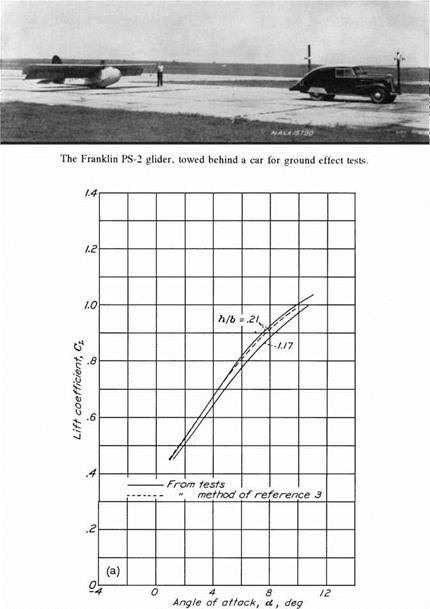Ground Effect
The fact that the close approach of an airplane to the ground is accompanied by substantial changes in its aerodynamic characteristics has been known for some time.
This is the opening statement in an NACA report by J. W. Wetmore and L. I. Turner, Jr. (1940). Ground effect theory dates from 1922 to 1924, with work by C. Wieselsberger in
Germany and H. Glauert in Britain. The stability and control effects of the close approach of an airplane to the ground primarily are in longitudinal control and trim. A conventional or tail-last airplane requires more nose-up longitudinal control to hold particular angles of attack, or to stall, near the ground. Likewise, the presence of the ground increases the amount of nose-up control required to lift the nose wheel during takeoff ground runs.
It is interesting that the aerodynamics of an airplane model under test in a closed test section wind tunnel and that of a full-scale airplane near the ground are treated by similar theoretical methods. The solid flow boundaries caused by the wind-tunnel walls and by the ground under the airplane are represented in theory by images of the model or airplane whose downwash and sidewash flows just cancel the flow velocities that would ordinarily cross the solid boundaries.
The ground effect case is altogether simple, since a single image system does the cancellation exactly The required image is a mirror image of the airplane, the ground itself taken as the mirror’s surface. On the other hand, for closed test section wind-tunnel walls an infinite series of images is required. Of course the most distant images are neglected for practical calculations.
The mirror image method of representing ground effect carries over into the modern application of computational aerodynamics to stability and control. That is, vortex lattice models give ground effect on longitudinal control and trim when an image vortex lattice system is added to the basic airframe lattice. This application was used in estimating ground effect for a recent tailless airplane design.
In contrast to the generally well-understood ground effect theory and mathematical modeling, ground effect measurements in the wind tunnel and in-flight testing are usually less than satisfactory. Low-speed wind-tunnel model tests of new designs, if they are reasonably well funded, generally include a few ground board tests. A board spanning the wind tunnel and extending some distance ahead of and behind the model is supported at a distance representing the ground. Pitch runs with ground board in place and removed give the desired ground effect increments in lift, drag, and pitching moment.
There are two main problems with ground effect wind-tunnel model tests, aside from the normal scale or Reynolds number differences between model test and the full-scale airplane. The ground board installation itself creates flow blockage in the wind tunnel, with unwanted cross-flow and buoyancy influences on the measurements. Also, a boundary layer stands on the ground board, starting at the leading edge of the board. There is no analog to the ground board boundary layer in real landings or takeoffs. The ground board boundary layer can be minimized by bleeds or by using a moving belt in place of the ground board. However, blockage effects must somehow be subtracted from the data.
Ground effect flight tests are equally problematic, if one wants to measure actual increments in lift and control angles for trim rather than just whether the airplane has satisfactory control in the presence of the ground. The difficulty is of course maintaining stabilized flight at different angles of attack while flying with wheels inches from the ground and making measurements.
The Wetmore and Turner 1940 work that is quoted at the start of this section was a model of clever flight test design. The problem of getting stabilized flight near the ground was solved by taking ground effect measurements on a glider towed behind a car (Figure 14.7). Car buffs will enjoy the photo of NACA’s tow car. It appears to be a Chevrolet faired to resemble a Chrysler Airflow sedan. The glider pilot maintained the prescribed height above the ground by sighting targets mounted on the car.
|
Figure 14.7 Lift coefficient versus angle of attack at two distances from the ground, as measured with a Franklin PS-2 glider towed behind a car. (From Wetmore and Turner, NACA Rept. 695, 1940) |
Stabilized flight near the ground could perhaps be maintained for modern ground effect tests using autopilot loops closed around height-finding signals, such as given by radar altimeters. Likewise, NASA has a model-launching rig at Langley Field that can obtain ground effect data without wind-tunnel ground board problems. The Langley rig also simulates any unsteady aerodynamic effects that may be significant. That is, real landings are dynamic affairs in that the airplane comes near the ground and lands in some time that may be short compared with the time required for stabilized flows to be established. Limited
vortex lattice calculations show that dynamic effects cause an increase in lift and pitching moment due to ground effect, as compared with steady-state conditions.












